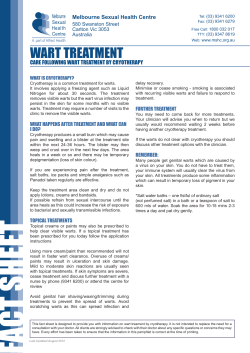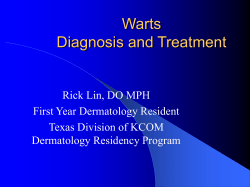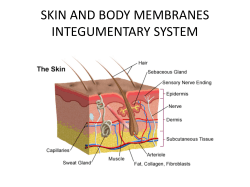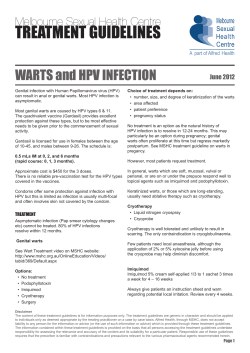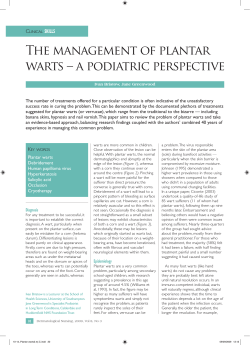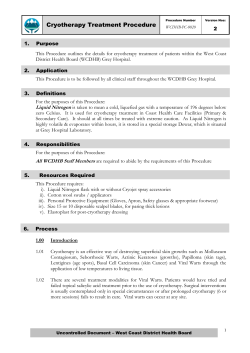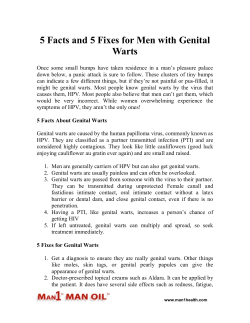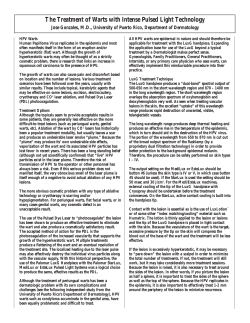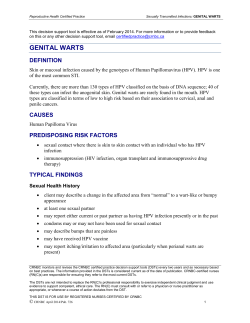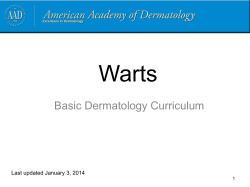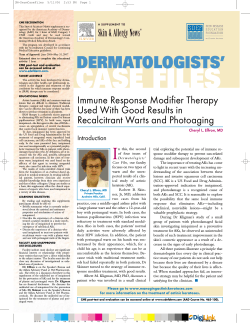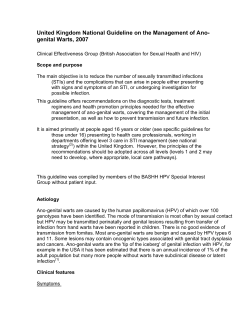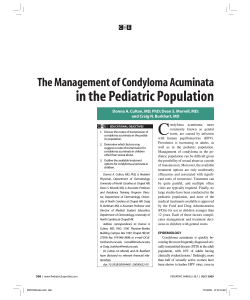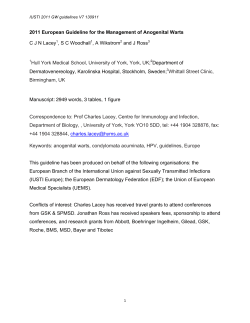
A new treatment for warts (patented)
Off-print From n°329 - April 2009 A new treatment for warts (patented) Although warts are an extremely frequent indication in dermatology, there has been little therapeutic innovation during the last twenty years. Verrutop® is a promising new wart treatment developed by the company Auriga. Verrutop® combines a mechanism that “mummifies” the wart with a painless approach. The product was presented to dermatologists during a debate organised during the French Interdisciplinary Dermatology Conference. A new treatment for warts (patented) illary tubes for application. As Auriga did not want patients to treat themselves, the product is proposed to the dermatologists and clinics who want to use it. Pharmacological presentation From the lecture of Alfred Marchal (research pharmacologist and chairman of Auriga) Evaluation of product efficacy Verrutop®: ex vivo study of epidermal necrosis The main active ingredient of Verrutop® is nitric acid (65%), though the caustic effect of this compound alone is not sufficient to mummify the wart. The real active substance is NO2 which acts by denaturing proteins. Nitric acid was combined with organic acids (acetic acid, oxalic acid, lactic acid), causing a redox reaction and participating in the internal production of NO 2. This aqueous solution acts much more effectively than nitric acid. Verrutop® only has a local action; it binds very rapidly to the wart tissue while sparing and respecting the healthy skin (it does not cross the basement membrane). Necrosis is initiated by the nitric acid and catalysed by the production of nitrite. Protein degradation induced by NO 2 is accelerated by the copper and zinc contained in the Verrutop® formulation. Verrutop® is very stable and has a long shelf-life (more than 5 years) when stored at room temperature; on the contrary the product is degraded at low temperatures so it should not be kept in the refrigerator. Verrutop® has a medical device status and is indicated for the treatment of all types of skin warts. It is presented as a kit of 5 ampoules of 200 µl and cap- From the lecture by Philippe Humbert (Saint-Jacques Hospital, Besançon) The efficacy of Verrutop® was evaluated at the Besançon skin engineering laboratory in comparison with liquid nitrogen. The two products were tested on an ex vivo model of warts placed on de-epidermized skin. The results obtained on 5 warts treated by Verrutop® (applied for 30 seconds) were compared with those of 5 warts treated by liquid nitrogen (applied for 30 seconds until a halo of frozen tissue of 1 to 2 mm was obtained around the wart); 8 untreated warts were used as control. The change in the necrosis obtained was observed on histological sections prepared at 15 minutes, 2 h, 6 h, 12 h and 24 h. Staining with hematoxylin-eosin (HE) and immunostaining with anti-Ki67 and anti-cytokeratin 10 were also performed (Ki67 is a marker of keratinocyte/basal layer pro- 15 min (x 10) 6h (x 20) Koilocyte Surgical adhesive Dermal support 2h (x 10) 12 h (x 10) Start of necrosis Condensation of epidermal structures Figure 1. Histological section of a plantar wart (x10) treated by Verrutop®. Start of epidermal necrosis at 2 hours; epidermal necrosis at 6 hours; epidermal necrosis and condensation of the epidermal structures at 12 hours. 2 A new treatment for warts (patented) D0 D7 D14 D35 Figure 2. Verrutop® was applied a single time on D0. The necrosed wart (yellow) was scratched with the surgical knife at 7 days; Healing. liferation; K10 is a marker of the granular and corneal layers). Signs of epidermal necrosis can be seen on histological sections from 2 hours after the application of Verrutop® (figure 1); this then continues until a condensation of the epidermal structures is obtained and all the cells have completely disappeared. These results are identical to those obtained with liquid nitrogen. Immunostaining also shows the disappearance of corneocytes in the wart as a result of wart necrosis which was also similar with Verrutop® and liquid nitrogen. Control warts retained their structure at the 24th hour. The application of Verrutop® therefore leads to morphologically and chronologically similar necrosis to that observed with liquid nitrogen. Verrutop® in practise ● Degrease the wart with alcohol. ● Remove the corneal layer of the wart with a scalpel (without bleeding). ● Apply the product with the capillary tube provided (either leave to dry or press/rub). ● Allow the product to completely penetrate and then repeat the application 2 to 3 times at 5 minute intervals. The yellowing of the wart shows necrosis, but there is no need to wait for this during the visit (figure 2). ● Cover with a bandage at the end of the visit if necessary (if the product runs). Use of Verrutop® by private dermatologists ● On the following days, clean the wart with alcohol daily. ● Average cost of a box of 5 ampoules: 49 €. ● Several patients may be treated with the same ampoule (on the same day). From the lecture by Jean Bourlond (Dermatologist, Namur, Belgium) ● The product may be kept for 5 years. Warts are epithelial proliferations that are contagious (particularly in public swimming pools) as they are caused by a virus (HPV). Their prevalence has clearly increased over the last 20-30 years and is estimated to be 7 to 10%. They very frequently affect school children who therefore fill the dermatologist’s office on days without school. Parents are often discouraged by the repetitive nature of the visits, the pain caused by repeated treatments, the incidence of reoccurrences and finally the cost it represents. - Flashlamp pulsed dye laser though not all dermatologists are equipped; - Keratolytics and various acids available over the counter. These are often used as self medication with slight or no efficacy; - Bleomycin; this has a few contraindications (periungueal wart, pregnant women, transplant patients), and sometimes leads to extensive necrosis; it is mainly used for the treatment of single large warts in adults; - Surgery (electrocoagulation); this sometimes causes troublesome scaring; - Homeopathy, alternative medicine; based on autosuggestion. New compounds include dichloronitrobenzene and diphenciprone though these products have the disadvantage of being very irritating and allergising. Disadvantages of conventional treatments Warts may disappear spontaneously, but it is difficult to propose abstention from treatment to patients who have come to obtain treatment for warts, and because of their high contagiousness. The various conventional treatments for warts include: - Liquid nitrogen (increasingly often available over the counter), the main disadvantage of which is pain; 3 Value of Verrutop® garis, myrmecia or HPV 1-induced warts, superficial warts induced by HPV 2 and plantar warts. Apart from its innovative value, the Verrutop® device has many advantages. It is easy to use, and extremely safe (the normal epidermis does not absorb the product), there are no contraindications and it requires no specific equipment and is easy to store. It is as effective as cryotherapy and requires the same number of sessions. It is also effective for secondline therapy after initial treatment failure. It may be used as an adjunct to other treatments in particular in the case of profuse and numerous warts. In particular, its application is completely painless. A complete cure (necrosis and removal of the wart) may be obtained after a single application, but generally, 2 to 3 sessions with ten-day intervals are necessary. Verrutop® may be applied on all types of wart: verrucae vul- Conclusion Verrutop® is the first innovation in this field for many years. It is as effective as liquid nitrogen, the most commonly used treatment for warts, and is completely painless and safe, which is an unquestionable advantage for the treatment of children. L. SICSIC Debate organised by Auriga, Paris, Assises Interdisciplinaires de Dermatologie 2009. Edited by L.E.N. Médical 15, rue des Sablons – 75116 Paris – Tel: 33 (0)1 47 55 31 31 - Fax: 33 (0)1 47 55 31 32 E-mail : info@len-medical.fr Publishing Director Dr L. Elgozi Chief Editor Pr P. Humbert Assistant Chief Editor Dr L. Sicsic All rights reserved 2nd quarter 2009 - Imprimerie de Compiègne 4 112367 A new treatment for warts (patented)
© Copyright 2025
